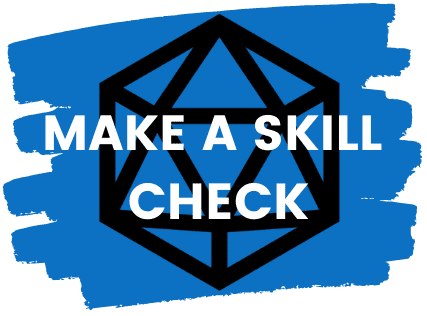Most people familiar with D&D seem confused about how nonmagical/mundane fire works. There are spells, such as Fire Bolt and Create Bonfire, that explicitly mention setting objects on fire. But how does that work once they’re burning?
RAW, there is no official rules for how mundane fire acts or does damage. Currently, DMs either control the fire narratively or use homebrewed rules. Our suggestion: Embers have 50% to become small fires. Small fires become large after one round. Large fires are more complex. Read on!
First, let’s take a look at some stats.

Table of Contents
Rules: Specific Beats General
If a specific rule contradicts a general rule, the specific rule wins.
–DnDBeyond
This can lead to some confusion in this area because there are specific rules in the fire spells that can be unclear.
For example, Fire Bolt says:
A flammable object hit by this spell ignites if it isn’t being worn or carried.
Odd that they have this specific rule while no rules about what the resulting fire will do. Does this imply that spells (that don’t state otherwise) will set everything on fire, including worn or carried objects? Do they set nothing on fire? Is it case by case?
Generally, there seems to be a ban on things being worn or carried ablaze; the first interpretation is probably not the intended one.
“Setting nothing on fire unless stated” also is a bit lame because then Produce Flame can’t so much as light a campfire. It would be odd if Prestidigitation was more capable at lighting things on fire than an explicit flame spell, no?
Personally, I recommend doing it case by case and what makes sense.
Produce Flame should light things on fire if they want, within reason. If Fire Bolt can do it, then most explicit fire spells can likely do the same.
Fireball and other similar offensive spells are debatable because it’s an explosion. A flash of intense heat that destroys things seems more likely to blow things away/apart than to set them afire.
Disagree? By all means, do whatever you think makes the most sense.
In short: I rule that most fire spells can set flammable objects (that aren’t worn or carried) on fire, and may make exceptions for spells that are more explosive than pure fire damage.
But generally, fire happens, especially while PCs are around.
Mundane Fire Mechanics
So you’ve set the crates in the corner on fire. Now what?
How much damage do you get by interacting with the object? How about putting it out? What if you do nothing and watch the pretty flames engulf all you can see?

It makes sense to have fire as a semi-static amount of damage, depending on the intensity of the fire.
Intensity
There are three levels of intensity:
- Embers: Each round, it has a 50/50 shot of fizzling out or moving up one level to…
- Small Fire: If left alone for 1 round, it will grow into a large fire. Takes up 1 square and can be treated like a campfire. In terms of damage, follow the same rules as create bonfire. A small fire doesn’t fill the cube, rather being a modest fire until it becomes a…
- Large Fire: a 5’ cube of fire! Each fire that has space to grow will expand by 1 square; this requires the intended squares to contain flammable materials. If more than one square is available, roll dice to determine which direction. For example, using a d4 for cardinal directions or a d8 if you want to include diagonals as options. The new fire created will start as a small fire.
Extinguishing
Embers can be stamped out without much fuss—an action or bonus action will work.
Small Fires work the same, except they move the flame down to “ember” form unless doused with water or otherwise smothered.
Gust, Prestidigitation, Druidcraft, and other such spells can entirely extinguish small fires and embers.
Large Fires
Unless sufficient liquid (e.g., a full water skin) or relevant spell (e.g., Create or Destroy Water) is applied to the flames, you will have to interact with the fire, either kicking at it or beating it with a cloak.
In that context, perform a Survival check to efficiently figure out how to deal with this natural element, fully extinguishing the flame in that square.
The DC is related to how many large fires are adjacent to the one you’re tackling. Fire feeds other fires and builds in intensity. Therefore:
DC 10+n
Where n is “the total number of adjacent large fires,” meaning it will range from DC 10 if alone to DC 18 if it’s completely surrounded.
If you fail the check, you’ll get burned for 1d8 fire damage but still succeed in decreasing the size of the fire to a “small” instead of fully extinguishing like a successful check would grant.
Damage
Large fires do more damage for every large fire adjacent to them, not including diagonals.
Create bonfire does 1d8 fire and is described as a 5’ cube of fire. I’ll be using that as a basis for mundane fire.
When first entering or starting your turn in a large fire, take (1+n)d8 fire damage, where n is still the number of large fires next to this one.
And yes, this does mean that it can do a whopping 5d8 fire damage if 4 other blazing cubes of flame surround the fire. It’s clearly unwise to go running through a roaring blaze.
Moving through fire-engulfed spaces will allow a DC13 Dex save to take half damage.
Damage to the Burning Objects
I have two proposed answers for this:
- Timed Damage
Objects take 20% damage every round until the object is unrecognizable – but still-burning wreckage. Start the timer either whenever makes sense for the object in question.
Imagine a chair fully engulfed in flames. After 5 rounds, it’s no longer a chair; it’s pure fuel for the fire, allowing the fire to continue burning. Even after the fire is put out, what’s left is mere charred remains.
- Set Damage
Any object engulfed in flames will be destroyed if left alone for sufficient time but can be saved by extinguishing the flames. However, the object does not survive unscathed; if saved from a small fire, it will retain 75% of its max hp; saved from a large fire, it will be 40% of its max hp.
Damaged items like this could be fixed with Mending.
Collapsing Structures
I can’t imagine every possible scenario, so this will remain a DM’s call.
What sort of supports does the building have? How many vital ones remain?
Once it collapses, I’d suggest plot intervention or bludgeoning damage and then possible suffocation situations, depending on what they’re caught under.
Forest Fires and Burning Villages
This seems generally better used in a narrative sense, using time circles to determine what is being affected at what time seems to be the best measure.
You could treat each building with the same mechanics as the large fire, expanding to nearby available squares as time goes on, but it might be easier to simply expand it as the narrative requires.
Cinderlings: Scamps of Living Fire
Now that we have a mechanic mundane fire, check out the fire snakes on a (material) plane with our Cinderlings Bestiary!
At first glance, the glass dome seems to encase a small burning log, highly out of place amid the tiny beasts, natural and magical, in the surrounding enclosures. “Don’t let your eyes fool you; this right here is an animal just like my sparrowmouse friend,” says the merchant, “it just happens to be made of fire! Look closer, and you’ll see it’s as adorable as it is ravenous!”
And indeed, the flames upon the log have some structure to them. They constitute one single entity, whose shape reveals itself to the eye once you know how to spot it. “It’s a cinderling, a small fire elemental, curled up like a sleeping ferret.”
Enrich your world with a new type of fire elemental that comes in many flavors—from novelty familiars to endgame bosses, celestial allies to scheming political figures, and more to be discovered!
Summary
Nice, short article on what I propose for mundane fire and its damage.

Recap my suggestions:
- Most fire spells can set flammable objects on fire, though concussive spells are at a DMs discretion (e.g., Fireball)
- Intensity levels:
- Embers: If left for 1 round, it will grow into a small fire. It can be snuffed as a bonus action.
- Small Fire: If left alone for 1 round, it will grow into a large fire. Takes up 1 square and can be treated like a campfire. A small fire doesn’t fill the cube, remaining a modest fire until it becomes a…
- Large Fire: a 5’ cube of fire! Each fire with space to grow will expand by 1 square; choose the one that makes the most sense and has flammable materials. To randomize, use a d4 for cardinal directions or a d8 to include diagonal squares. The new fire created will start as a small fire.
- Extinguishing:
- Embers can be stamped out without much fuss — an action or bonus action will work.
- Small Fires work the same as embers but move down to ember form unless doused with water or otherwise smothered. Otherwise, they’re merely stomping it out for a turn.
- Gust, Prestidigitation, Druidcraft, and other such spells can entirely extinguish small fires and embers.
- Large Fires: Unless sufficient liquid (e.g., a full water skin) or relevant spell (e.g., Create or Destroy Water) is applied to the flames, perform a Survival Check (DC 10+X; X = the total number of adjacent large fires [DC 10 to 18])
- Damage to Creatures
- Embers: No damage, unless one creature is actively pushing another’s face into them. In that case, improvise damage (article here).
- Small Fires: Treat the same as the create bonfire spell
- Large Fires: When first entering or starting your turn in a large fire, take (1+n)d8 fire damage with a DC13 Dex Save to take half damage. n = the number of large fires one square away from this one.
- Damage to the Objects (2 Options):
- Timed Damage: 20% damage per turn to objects; after 5 rounds, the object is destroyed. The fire continues to burn until all materials are consumed or otherwise extinguished. Start the timer whenever makes sense for the object in question.
- Set Damage: “Any object engulfed in flames will be destroyed if left alone for sufficient time (DM discretion) but can be saved by extinguishing the flames. However, the object does not survive unscathed; if saved from a small fire, it will retain 75% of its max hp; saved from a large fire, it will be 40% of its max hp. This can be repaired through the mending spell.”







0 Comments